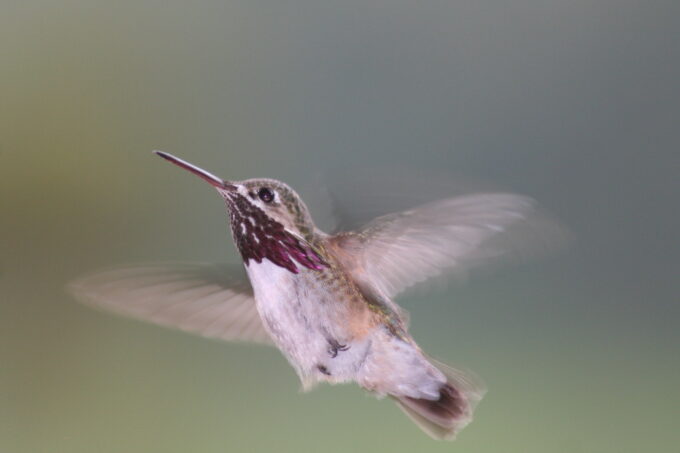Why Humingbirds are in Rapid Decline
In Native American lore, bees symbolize community; Celtic myths tell us bees are spirit messengers from the Otherworld. Around the world, butterflies evoke the promise of metamorphosis. And the sparkling, hovering hummingbirds, because they are impossibly tiny and fast and beautiful, are emblems of irrepressible life. The Aztecs believed hummingbirds, who are furious fighters, are More
The post Why Humingbirds are in Rapid Decline appeared first on CounterPunch.org.

Calliope hummingbird hovering. Photo: Kati Fleming, CC BY-SA 3.0.
In Native American lore, bees symbolize community; Celtic myths tell us bees are spirit messengers from the Otherworld. Around the world, butterflies evoke the promise of metamorphosis. And the sparkling, hovering hummingbirds, because they are impossibly tiny and fast and beautiful, are emblems of irrepressible life.
The Aztecs believed hummingbirds, who are furious fighters, are reincarnated warriors. They’ve returned to life with swords as beaks, continuing their battles forever in the sky. They called them huitzitzil and ourbiri—“rays of the sun” and “tresses of the day star.”
Early Spanish visitors to the New World, seeing hummingbirds for the first time (they only live in this half of the globe), called them “resurrection birds.” They believed that anything that glittered so brightly had to have been made new each day.
In the Dominican Republic, people call them suma flor—“buzzing flower.” The Portuguese called them beija-flor, or “flower kisser.”
The Great Pollinator Disappearance: Birds, Bees, and Butterflies Are All in Decline
Today, perhaps more than ever before, we thirst for community. We hanker for transformation. We long to reconnect with the incandescence of life. We need to make those inner journeys. But what if there are no bees or butterflies or hummingbirds to accompany us?
It’s a growing possibility. A shocking number of pollinators, including hummingbirds, are in dire danger. Honeybees are suffering from colony collapse disorder. Bumblebee populations are crashing. You are 50 percent less likely to see a bumblebee than you were in 1974.
Butterfly populations have decreased, according to one estimate, by 33 percent since 2000.
Three billion birds—one in four—have disappeared from North American skies since 1970. Audubon’s “Birds and Climate Change Report” (2014) warns that half of all birds in North America are at risk, and it singles out four species of hummingbirds—including the Allen’s hummingbird (Selasphorus sasin)—projected to lose 90 percent of their small breeding range due to human-induced climate disruption by 2080.
Birds: Made for and of Air
Hummingbirds embody so many opposites that their very existence seems a miracle. They are the lightest birds in the sky—and also, for their size, the fastest. These tiny, fragile birds undertake perilous, long-distance migrations. The rufous hummingbird(Selasphorus rufus) flies on gossamer wings from Mexican wintering grounds to nesting areas in Alaska.
Birds are physiologically very different from us. Humans and our fellow mammals are fluid-filled creatures. Early Greek physicians believed all medicine could be based on an understanding of these fluids, which they called humors. But birds, in order to be freed for flight, cannot afford to be loaded down with heavy fluids.
Birds are made of air.
Unlike our thick, marrow-filled bones, most birds’ bones are hollow. Even their skulls are scaffolded with passageways for air. Their feather shafts are hollow, and the feathers themselves, like strips of Velcro, are interlocking barbules for catching air.
Their bodies are filled with air sacs, which originate in and function, in part, as extensions of the lungs. No fewer than nine of these filmy bladders fill the tiny body of a hummingbird: one pair in the chest cavity, another under each shoulder blade, another pair in the abdomen, one under each wing, and one along the neck.
Hummingbirds are the lightest birds in the sky. Of their roughly 240 species, all confined to the Western Hemisphere, the largest, the Andean Giant Hummingbird(genus Patagona), is only eight inches long; the smallest, the bee hummingbird(Mellisuga helenae) of Cuba, is just over two inches long and weighs a single gram.
Pure Magic: A Hummingbird in Flight
Delicacy is the trade-off hummingbirds have made for their unrivaled powers of flight. Alone among birds, they can hover, fly backward, and even fly upside down.
For such small birds, their speed is astonishing: in his courtship display to impress a female, a male Allen’s hummingbird, for instance, can dive out of the sky, reaching sixty-one miles per hour, plunging from fifty feet at a rate of more than sixty feet per second—and pulling out of his plunge, he experiences more than nine times the force of gravity.
Adjusted for body length, the Allen’s is the fastest bird in the world. Diving at 385 body lengths per second, this hummer beats the peregrine falcon’s dives at 200 body lengths per second—and even bests the space shuttle as it screams down through the atmosphere at 207 body lengths per second.
And because of—not in spite of—their delicacy, hummingbirds can execute acrobatics that no other bird can approach. Alone among the world’s ten thousand avian species, only those in the hummingbird family, Trochilidae, can hover in midair. For centuries, nobody knew how they did it. They were considered pure magic.
This adapted excerpt is from The Hummingbirds’ Gift by Sy Montgomery (Atria Books, 2021) and is licensed under Creative Commons Attribution-NonCommercial-ShareAlike 4.0 International License (CC BY-NC-SA 4.0) by permission of Atria Books. It was adapted and produced for the web by Earth | Food | Life, a project of the Independent Media Institute.
The post Why Humingbirds are in Rapid Decline appeared first on CounterPunch.org.
